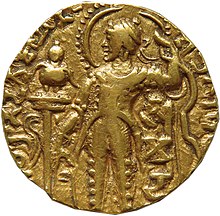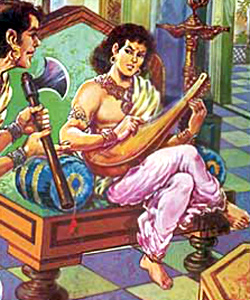He was kind of over-exaggerating. The practice of cartography, according to P.D.A. Harvey, who wrote "The History of Topographical Maps," was either not very popular, or has left us with little evidence of its existence, but it is not non-existent, as Bagrow claims. This may have, perhaps, had something to do with the emphasis on an oral language that the religious class of ancient India employed, but as we will see during the Age of Gupta, written works became quite popular among the ruling class of kings.
The earliest distinctly Indian map is a pictorial representation of a continent called Nandisvaradvipa, a mythical place, in 1199-1200 A.D. The map shows a series of rings representing continents, the inner-continent being Jambudvipa and the outermost the place where lesser deities held festivals. I tried putting a picture of it on this blog, but it has been copyrighted. If you go to this link on uchicago.edu, you should be able to see it on page 296 (but beware, it takes a pretty long time to load).
Other maps were etched onto potsherds in 200-100 BC. They showed pictures of monastery plans or great rivers. They would look similar to these potsherds:
Other pictorial maps probably existed, as in most civilizations, but it is hard to determine which maps were influenced by a European tradition for the inhabitants of southern Asia.
I would like to mention now about the contrast with how the Brahmin felt about having their ancient scripture written down, and the popularity of poetry and written works during the age of the Gupta, as Ghosh tells us in "The History of Education in Ancient India." If you'll remember, in an earlier post, we find out that the Brahmin find the writing down of scripture sacrilegious, perhaps in part because it means less power for them.
Ghosh explains that in the Gupta Age, which was between 320BC and 550AD, Samudragupta, ruler of the Gupta Empire after Chandragupta I, was in fact called "Kaviraja," or "king of poets." During this golden age of India, poets were sponsored by kings so that there would no longer be "the war between good poetry and prosperity" (Ghosh, 148).
 |
| Samudragupta's father, Chandragupta I, and his mother |
 |
| Samudragupta |
 |
| Kalidasa, the poet |
 |
| Shakuntala and Dushyanta |
He gives her a ring before he needs to leave for the capital, but when Durvasa, a hermit who loves her, finds out about Sakuntala's marriage, he curses her so that her husband will not recognize her until he sees her ring. The Sage Kanva, her foster-father, sends Sakuntala to the capital, knowing she is pregnant, but the ring has been lost and the king does not recognize her.
When the chief priest wants to adopt her because he knows who Sakuntala is and that her son will fulfill prophecy, she is taken by her mother up into heaven. A fisherman, in the meantime, finds the ring, and when the King sees it, he knows what has happened. Feeling sorrowful and distraught at the loss of his wife and son, the king later happens upon a boy who is wrestling with a lion cub at another hermitage, where he discovers his wife, and finds that this noble boy is his son.
 |
| Bharat wrestling a lion |

Because the ancient Indian culture did not value cartography, it makes me wonder why they didn't see maps as important. Could it be because their culture didn't outwardly explore other lands? That their civilization did not strive for more land and citizens/slaves as an empire would? Could it be that other topics or needs in society took precedence over making maps (like writing plays)?
ReplyDeleteInteresting to think of map making as a type of written knowledge. Without maps, the world is essentially closed. False assumptions about the unknown are made (ex. the world is flat).
ReplyDeleteWithout complete maps of the world, knowledge is limited and isolated.
Summer, I also find it interesting why they don't value maps while other cultures made it one of the most important parts of their societies. It seems like European nations were the most set on conquering and exploring new lands, at least in the past millenium, and they seem to be one of the cultures that places a lot of importance on mapping things. Same thing with ancient Eastern Asian conquering societies.
ReplyDelete